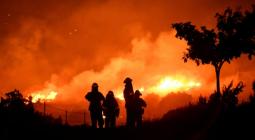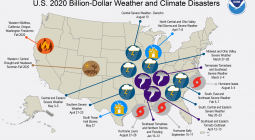State of Climate Services 2020 Report: Move from Early Warnings to Early Action.
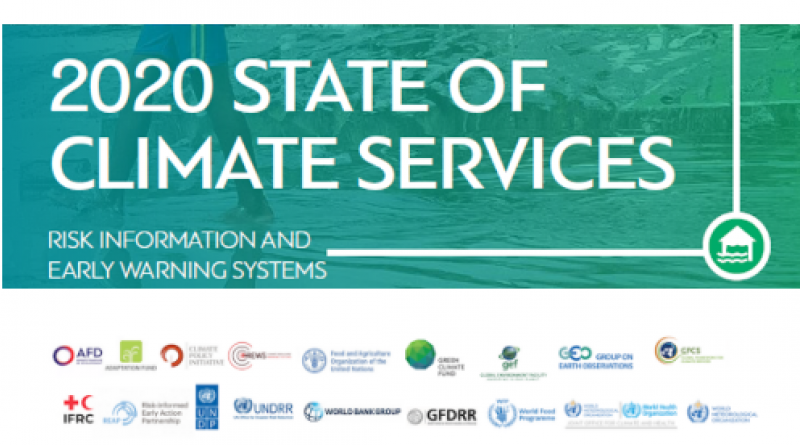
Geneva, 13 October 2020 - Over the past 50 years, more than 11,000 disasters have been attributed to weather, climate and water-related hazards, involving 2 million deaths and US$ 3.6 trillion in economic losses. While the average number of deaths recorded for each disaster has fallen by a third during this period, the number of recorded disasters has increased five times and the economic losses have increased by a factor of seven, according to a new multi-agency report.
Extreme weather and climate events have increased in frequency, intensity and severity as result of climate change and hit vulnerable communities disproportionately hard. Yet one in three people are still not adequately covered by early warning systems, according to the 2020 State of Climate Services report released on the International Day for Disaster Risk Reduction on 13 October.
In 2018, globally, around 108 million people required help from the international humanitarian system as a result of storms, floods, droughts and wildfires. By 2030, it is estimated that this number could increase by almost 50% at a cost of around US$ 20 billion a year, it says.
The report, produced by 16 international agencies and financing institutions, identifies where and how governments can invest in effective early warning systems that strengthen countries’ resilience to multiple weather, climate and water-related hazards and provides successful examples.
It stresses the need to switch to impact-based forecasting – an evolution from “what the weather will be” to “what the weather will do” so that people and businesses can act early based on the warnings.
The 2020 State of Climate Services report contains 16 different case studies on successful early warning systems for hazards including tropical cyclones and hurricanes, floods, droughts, heatwaves, forest fires, sand and dust storms, desert locusts, severe winters and glacial lake outbursts.
“Early warning systems (EWS) constitute a prerequisite for effective disaster risk reduction and climate change adaptation. Being prepared and able to react at the right time, in the right place, can save many lives and protect the livelihoods of communities everywhere,” said World Meteorological Organization (WMO) Secretary-General Professor Petteri Taalas.
“While COVID-19 generated a large international health and economic crisis from which it will take years to recover, it is crucial to remember that climate change will continue to pose an on-going and increasing threat to human lives, ecosystems, economies and societies for centuries to come,“ he said.
“Recovery from the COVID-19 pandemic is an opportunity to move forward along a more sustainable path towards resilience and adaptation in the light of anthropogenic climate change,” Professor Taalas said in a foreword to the report.
The 2020 State of Climate Services report provides a basis for understanding how to strengthen protection for the most vulnerable, including through mechanisms such as the Climate Risk and Early Warning Systems (CREWS) initiative, which together with l’Agence Francaise de Développement, provided funding for the report.
The report was coordinated by WMO and contains input from 16 different international organizations: l’Agence Francaise de Développement; Adaptation Fund; Climate Policy Initiative; Climate Risk and Early Warning Systems initiative; Food and Agriculture Organization of the United Nations; Group on Earth Observations; Green Climate Fund; Global Environment Facility; International Federation of Red Cross and Red Crescent Societies; Risk-informed Early Action Partnership; United Nations Office for Disaster Risk Reduction; United Nations Development Programme; World Bank Group and its Global Facility for Disaster Reduction and Recovery; World Food Programme; the World Health Organization – World Meteorological Organization Climate and Health Office, and WMO.
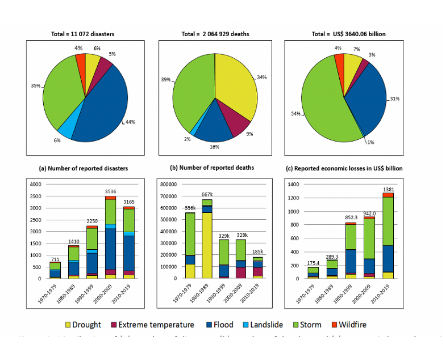
Capacity Gaps
Nearly 90 percent of Least Developed Countries and Small Island Developing States have identified early warning systems as a top priority in their Nationally Determined Contributions on climate change. However, many of them lack the necessary capacity and financial investment is not always flowing into the areas where investment is most needed.
The situation is particularly acute in small island developing states (SIDS) and least developed countries (LDCs). Since 1970, SIDS have lost US$ 153 billion due to weather, climate and water related hazards – a significant amount given that the average GDP for SIDS is US$ 13.7 billion. Meanwhile, 1.4 million people (70% of the total deaths) in LDCs lost their lives due to weather, climate and water related hazards in that time period.
Data provided by 138 WMO Members shows that just 40% of them have Multi-Hazard Early Warning Systems (MHEWS). This means that globally on average one in three people is still not covered by early warnings. Currently, only 75 WMO Members (39%) indicated that they provide impact-based forecasting services.
Dissemination of warnings is weak in many developing countries, and advances in communication technologies are not being fully exploited to reach out to people at risk, especially in LDCs.
There is insufficient capacity worldwide to translate early warning into early action – especially in LDCs. Africa faces the largest gaps in capacity. Across this vast continent, while capacity is good in terms of risk knowledge and forecasting, just 44,000 of people in 100,000 are covered by early warnings, in countries where data is available.
All weather and climate services rely on data from systematic observations. However, observing networks are often inadequate, particularly across Africa where, in 2019, just 26% of stations met WMO reporting requirements.
More is needed
An increase in climate-related disasters indicates that upscaling of adaptation investment across the board is required, including specifically in reducing weather-water and climate-related risks through investments in improving access to risk information and multi-hazard early warning systems enhancement.
The good news is that climate finance has reached record levels, crossing the US$ half-trillion mark for the first time in 2017-18. Action still falls far short of what is needed under a 1.5˚C scenario, however. Estimates include that US$ 180 billion will be needed annually for the period 2020-2030, as suggested by the Global Commission on Adaptation.
And despite annual tracked climate finance reaching the half-trillion-dollar mark for the first time in 2018, adaptation finance is only a very small fraction (5%) and financing for risk information and early warning systems is only a fraction of that.
Strategic Recommendations
The report makes six strategic recommendations to improve the implementation and effectiveness of early warning systems worldwide:
- Invest to fill the early warning systems capacity gaps, particularly in African LDCs and SIDS.
- Focus investment on turning early warning information into early action.
- Ensure sustainable financing of the global observing system that underpins early warnings.
- Track finance flows to improve understanding of where these resources are being allocated in relation to EWS implementation needs and what impact this is having.
- Develop more consistency in monitoring and evaluation to better determine early warning systems effectiveness.
- Fill the data gaps, particularly in SIDS.
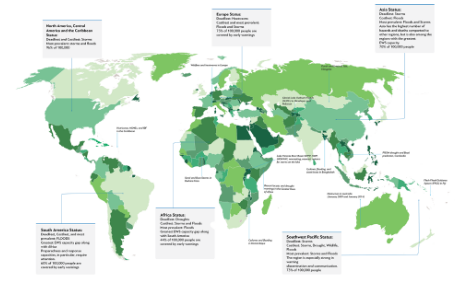
Messages
Mami Mizutori, Special Representative of the Secretary-General for Disaster Risk Reduction, UN Office for Disaster Risk Reduction (UNDRR):
“COVID-19 has made risk everybody’s business. We need to carry this understanding and momentum into the much bigger fight for our planet against the larger, stronger, more devastating climate emergency. Risk reduction, and in particular, climate adaptation requires strong risk governance and a multi-hazard approach. To date, 93 UN member States have developed national strategies for disaster risk reduction, and in turn, disaster risk reduction is a top priority in all National Adaptation Plans devised under the Paris Agreement. This needs to continue; a key challenge will be to ensure that multi-hazard early warning systems can be adapted to take account of biological hazards alongside extreme weather events.”
Qu Dongyu: Director-General of the Food and Agriculture Organization of the United Nations (FAO):
“Pre-emptive action underpinned by effective weather data, early warning systems and disaster risk assessments, can save millions of livelihoods in times of conflict and natural disaster.
“Early warning, Early actions” is therefore a key guiding principle for my administration in FAO to deal with potential risks for the global agri-food system, even before the latest outbreak of locust and the COVID-19 Pandemic.”
Mikko Ollikainen, Manager of the Adaptation Fund: “The year 2020 has highlighted the importance of building broad resilience in vulnerable developing countries, to climate change but also to health and economic risks. Climate services are critical in achieving resilience, and the Fund plays a crucial role in this partnership through its concrete adaptation projects on the ground serving the most vulnerable communities, with about 20 percent of its portfolio dedicated to supporting countries in building resilience through Early Warning System and Disaster Risk Reduction projects. The Fund also offers readiness support and new grant opportunities aimed at accelerating project scale-up, learning and innovation in adaptation, including disaster risk reduction.”
Yannick Glemarec, Executive Director, Green Climate Fund: “This report provides a timely warning of the need for climate services to protect the most vulnerable from devastating climate events. As the world’s largest dedicated provider of climate finance in developing countries, the Green Climate Fund (GCF) contributes to filling capacity gaps identified by WMO through its integrated financing of early warning components. This includes weather monitoring technology, training technical staff and building robust communication networks to ensure community members receive and understand climate information. GCF support also targets the most vulnerable – 74 percent of GCF’s USD 877 million funding allocated to date for climate information and early warning systems has been committed to LDCs, SIDS and African countries. GCF acts as a force multiplier linking disparate climate information networks at sub-national, national, regional and global levels to strengthen global climate observations. Our support ranges from better preparing Malawian fishing people from storm surges to enhancing infrastructure resilience in Caribbean nations such as Antigua and Barbuda now buffeted by increasingly frequent hurricanes. GCF’s collaboration with WMO is critical as we work to increase the use of climate information and early warning systems based on strong climate science.
13 October 2020
UN ENVIRONMENT

